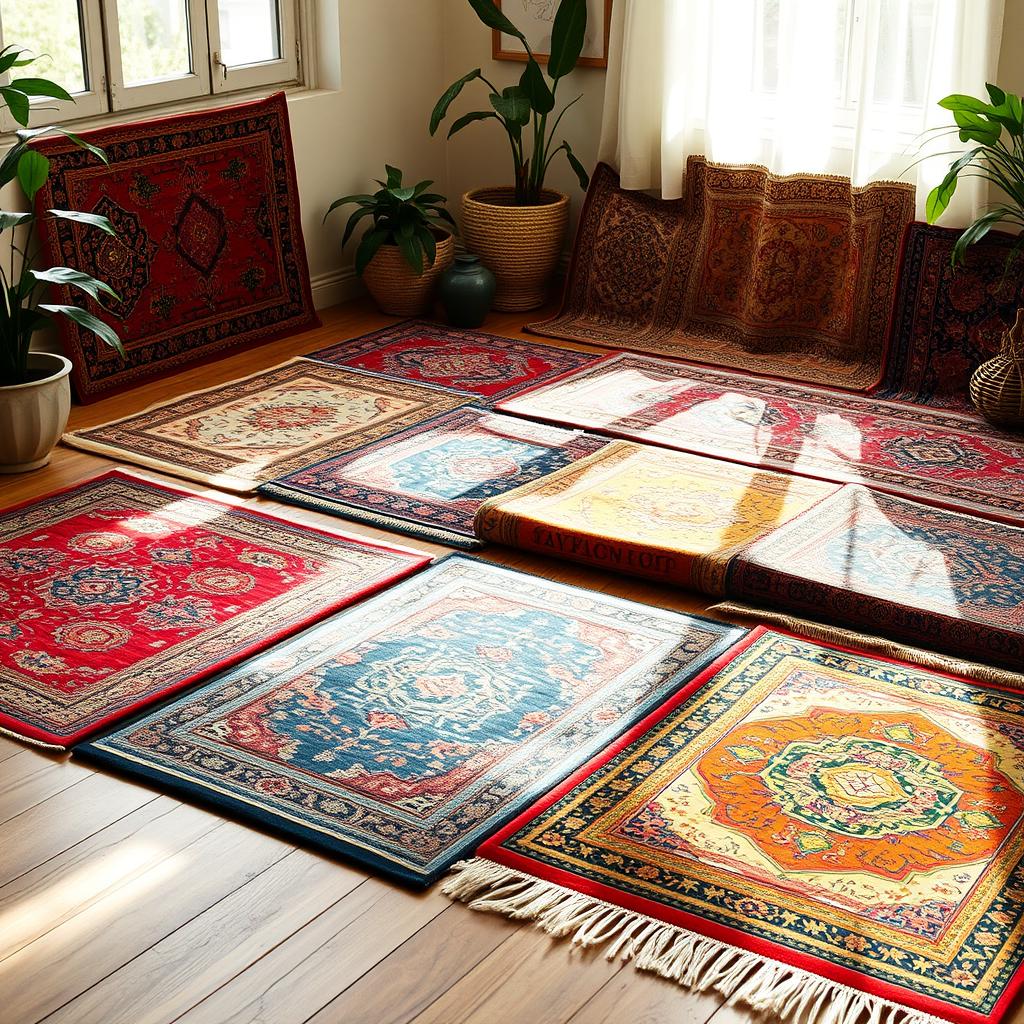Do you own a beautiful handmade or wool carpet? These carpets add elegance to your home and carry a rich cultural story. They are a big investment, and taking good care of them is key to keeping them beautiful for years. But how do you take care of these special textiles? Learn the expert tips and methods to protect your investment in traditional craftsmanship.
Click to use Silverigroup personal shopper services
Key Takeaways:
- Understand the unique value and cultural significance of handmade and wool carpets
- Learn essential maintenance tools and techniques to keep your artisan rugs looking their best
- Discover daily care routines and seasonal tips to extend the lifespan of your precious flooring
- Recognize common threats to natural fiber carpets and how to address them
- When and why to seek professional cleaning services for your investment-worthy rugs
Understanding the Value of Handmade and Wool Carpets
Hand-knotted carpets are more than just floor coverings. They are a showcase of centuries-old artistry. Each carpet is a unique piece, with intricate patterns and vibrant colors that tell the story of the region where it was made.
The Artistry Behind Hand-Knotted Pieces
Making a hand-knotted carpet is a long and detailed process. Weavers use old techniques, tying thousands of knots by hand. This makes the carpets not only beautiful but also very durable, lasting for generations.
Click to buy antique rugs from Silverigroup
Investment Potential of Quality Carpets
Handmade and wool carpets are not just pretty; they can also be a good investment. High-quality carpets can increase in value over time. Their rarity and cultural importance make them valuable to collectors.
Cultural Significance and Heritage
Hand-knotted carpets hold deep cultural value. They often show the history, symbols, and motifs of the communities that make them. These carpets are a link to the past and help preserve cultural heritage.
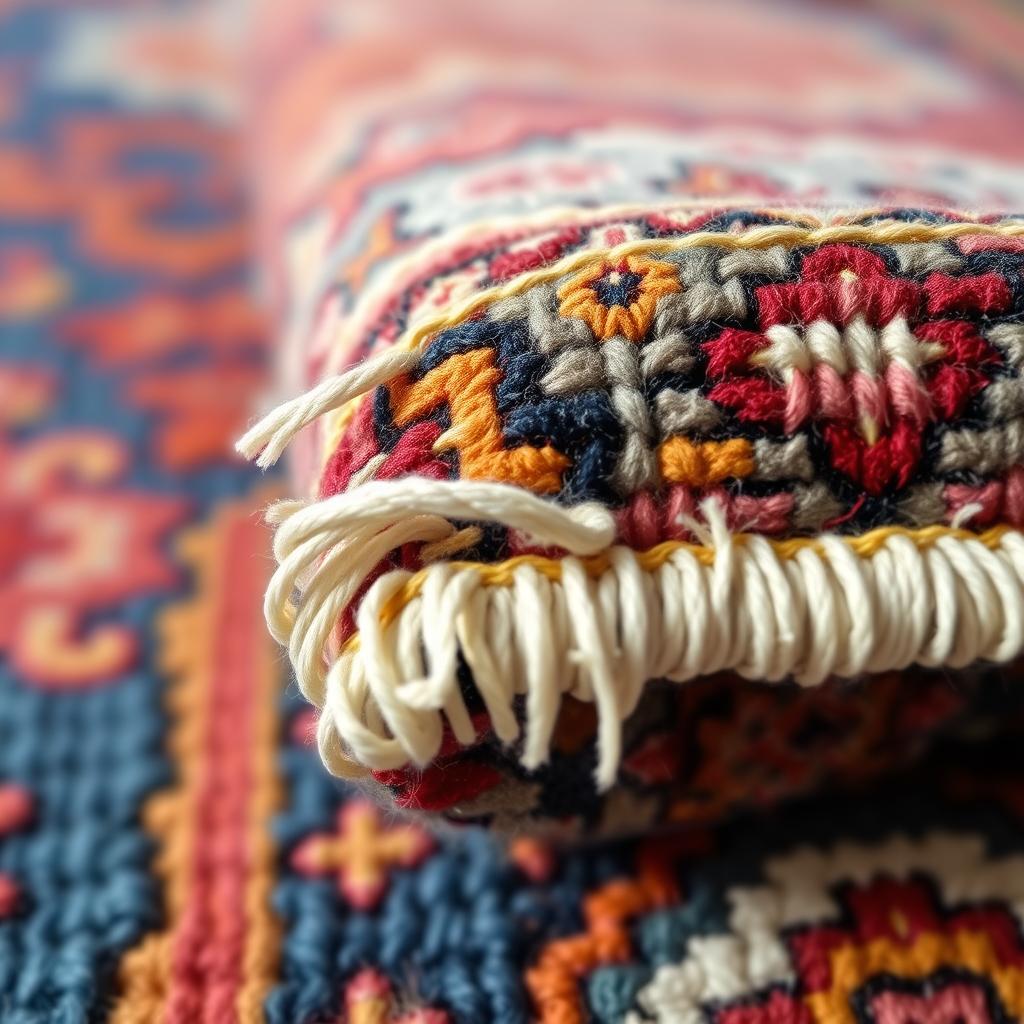
Essential Tools and Supplies for Carpet Maintenance
Keeping your natural fiber flooring, like handmade and wool carpets, looking great needs the right tools and supplies. These green options help keep your natural fiber flooring in top shape. They also make your home healthier and more eco-friendly. Begin with a top-notch vacuum that has HEPA filtration. It’s great for getting rid of dust, dirt, and pet hair without harming the air inside. Use a carpet attachment to clean gently but thoroughly, without harming the fibers.
For quick clean-ups, use a soft, pH-balanced carpet shampoo or a bit of mild dish soap mixed with water. Stay away from strong chemicals that can harm the fibers or change their color. Use soft-bristle brushes or clean, white cloths to gently remove stains without rubbing too hard.
| Essential Tools | Eco-Friendly Supplies |
|---|---|
|
|
For deeper cleaning, try natural solutions like hydrogen peroxide, white vinegar, and baking soda. They can tackle tough stains and smells without harming your natural fiber flooring. With the right tools and green supplies, your handmade and wool carpets will stay beautiful for many years.
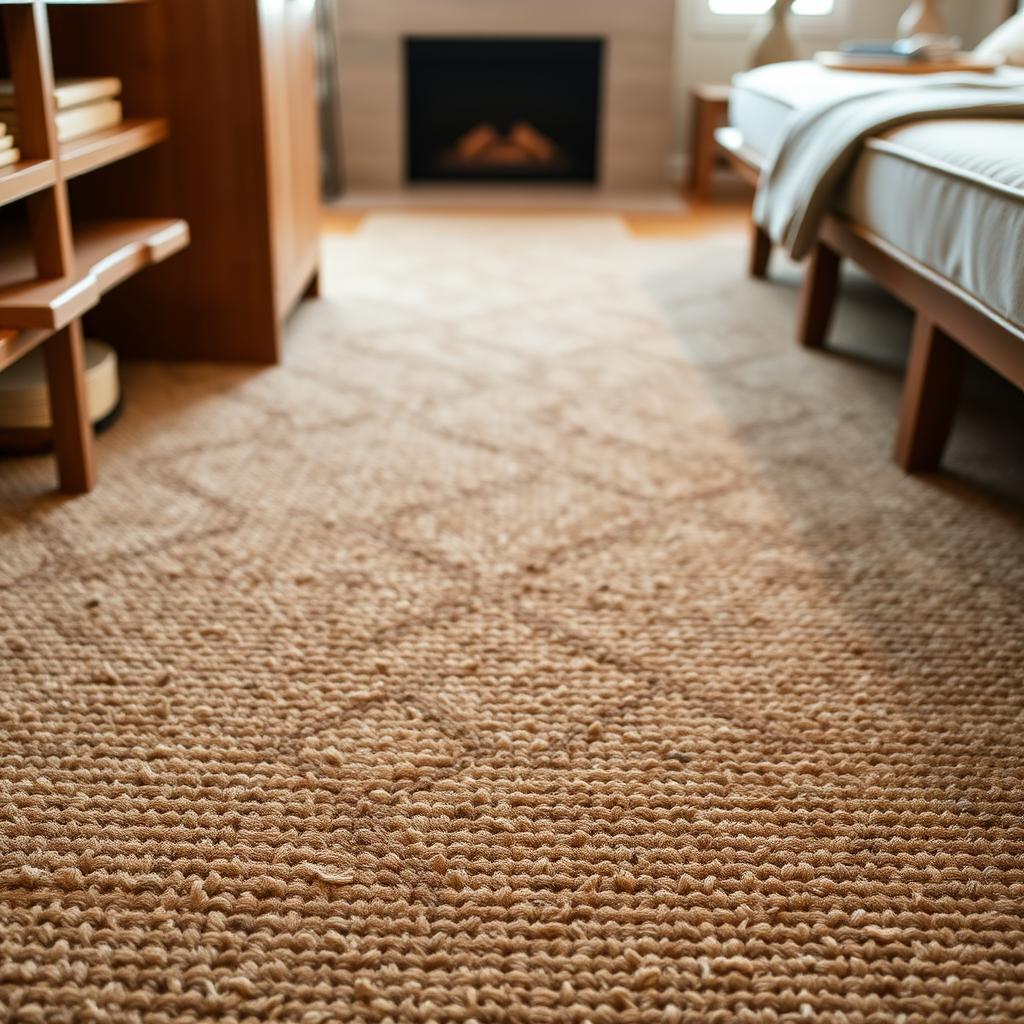
Daily Care Routines to Preserve Your Artisan Rugs
Keeping your artisan rugs looking great and lasting long needs a daily care plan. These special pieces of home decor should get the best care to stay loved for many years.
Proper Vacuuming Techniques
Vacuuming your artisan rugs often is key to keep them clean. Use a light suction setting and gentle moves to avoid harming the fibers. Focus on busy spots and change your vacuuming direction each time for even cleaning.
Spot Cleaning Basics
Spills and stains can happen, and quick action is vital. Blot spills right away with a clean cloth, without rubbing. For tough stains, use a mild cleaner and a soft brush, starting from the outside of the stain.
Rotation and Sun Exposure Management
- Rotate your artisan rugs regularly to ensure even wear and fading across the entire surface.
- Position your rugs away from direct sunlight, which can cause discoloration and deterioration over time.
- Consider using window treatments or area rugs to protect your artisan pieces from excessive UV exposure.
Following these daily care steps will help keep your artisan rugs beautiful and valuable. They will stay a wonderful, lasting part of your home decor.
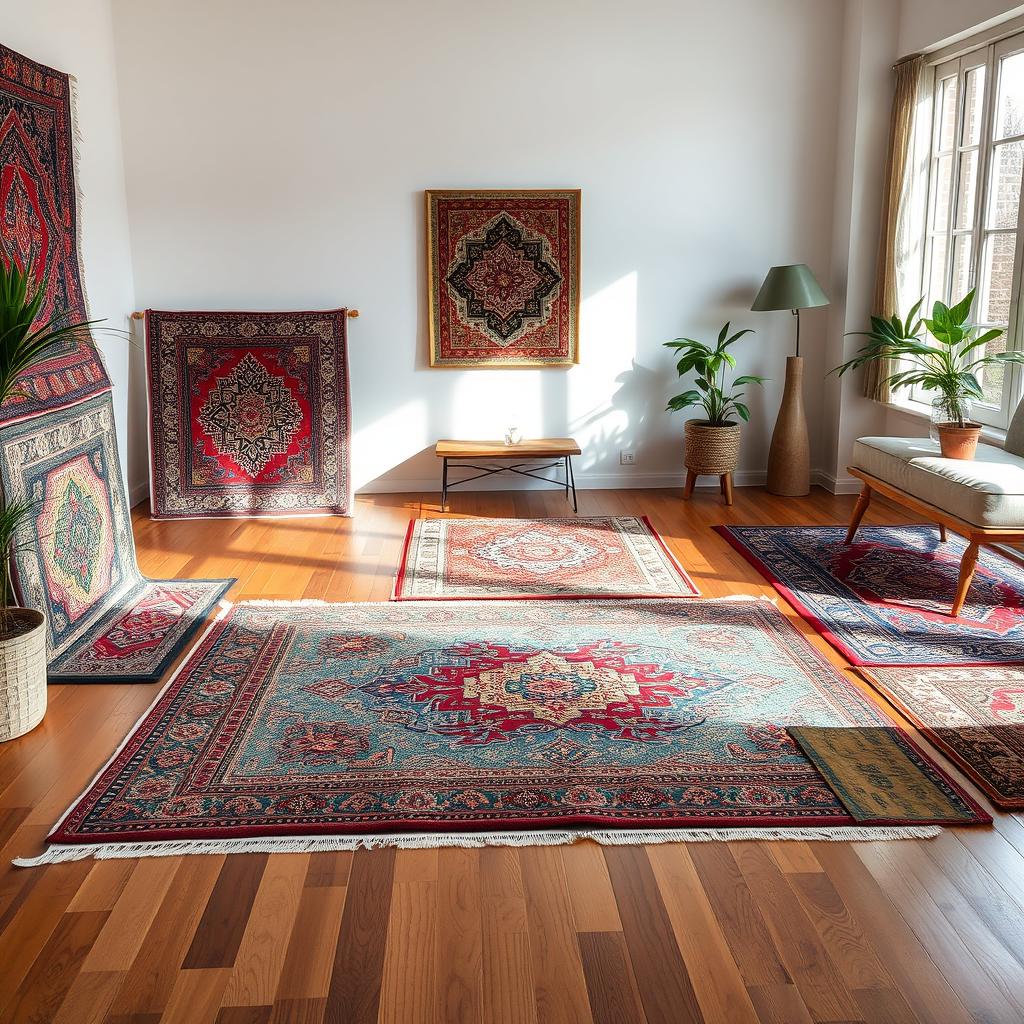
Common Threats to Natural Fiber Flooring
Keeping natural fiber flooring, like natural fiber flooring and eco-friendly floor coverings, looking great and lasting long is key. We must watch out for common dangers. These include environmental factors, pests, and wear patterns. Knowing these threats helps us keep our floors beautiful and strong.
Direct sunlight is a big worry for natural fiber floors. UV rays can make the fibers fade and change color. This can make the floors look uneven. To avoid this, place the floors right, rotate them, and use window treatments. Pests like moths, beetles, and rodents can also harm natural fiber floors. They can burrow into the fibers, causing damage and weakening the floor. To fight pests, clean regularly, use pest control, and keep an eye out for them.
Wear patterns from lots of foot traffic are another problem. High-traffic areas can get compacted and worn, looking uneven. To fix this, rotate rugs and furniture, and use protective measures in busy spots. By knowing and tackling these threats, we can keep our natural fiber flooring and eco-friendly floor coverings looking great for a long time.
| Threat | Impact | Preventive Measures |
|---|---|---|
| UV Exposure | Fading and discoloration of fibers | Proper placement, rotation, and use of window treatments |
| Pests | Damage to fibers and structural integrity | Regular cleaning, pest control, and vigilant monitoring |
| Heavy Foot Traffic | Uneven wear patterns and compaction | Rotating placement of rugs and furniture, protective measures in high-traffic areas |
Professional Cleaning: When and Why
Handmade and wool carpets need special care to stay beautiful and last long. Professional cleaners know how to handle these carpets well. They make sure your carpets get the best care possible.
Choosing a Qualified Carpet Cleaner
When picking a carpet cleaner, look for those who know about delicate rugs. They should understand the materials and how these carpets are made. Ask about their experience, certifications, and cleaning methods.
Cleaning Frequency Guidelines
- High-traffic areas: Clean every 12-18 months
- Medium-traffic areas: Clean every 18-24 months
- Low-traffic areas: Clean every 24-36 months
How often to clean depends on how much foot traffic and dirt your carpets get. Talk to your cleaner to find the best schedule for your carpets.
What to Expect During Professional Service
Professional carpet cleaning is a detailed process. It may include:
- Thorough vacuuming to get rid of surface dirt
- Gentle, targeted spot cleaning for tough stains
- Steam cleaning or hot water extraction to deep clean
- Specialized rinsing and drying techniques to leave carpets fresh
By choosing professional cleaners, you can keep your carpets looking great for a long time.

Seasonal Care Tips for Wool Carpets
Keeping your wool carpets looking great all year needs a seasonal care plan. You’ll need to manage humidity and protect from the sun. These tips will help your wool carpets stay beautiful and last longer.
Battling Humidity
High humidity can lead to mold and mildew on wool carpets. Use dehumidifiers or open windows on dry days to improve air flow. Vacuum often to remove moisture and debris that can cause problems.
Safeguarding Against Sun Damage
Wool carpets fade and lose color when exposed to direct sunlight. In summer, use curtains or move furniture to block UV rays. Rotate your carpet to spread out wear and sun damage.
Seasonal Cleaning Schedule
- Spring: Do a deep clean to get rid of winter dirt.
- Summer: Vacuum regularly to stop dust and dirt buildup.
- Fall: Clean often in high-traffic spots as kids and pets come back inside.
- Winter: Spot clean spills and stains right away.
Adjusting your wool carpets care with the seasons keeps them looking great. This way, your handmade carpets will stay beautiful and valuable for many years.
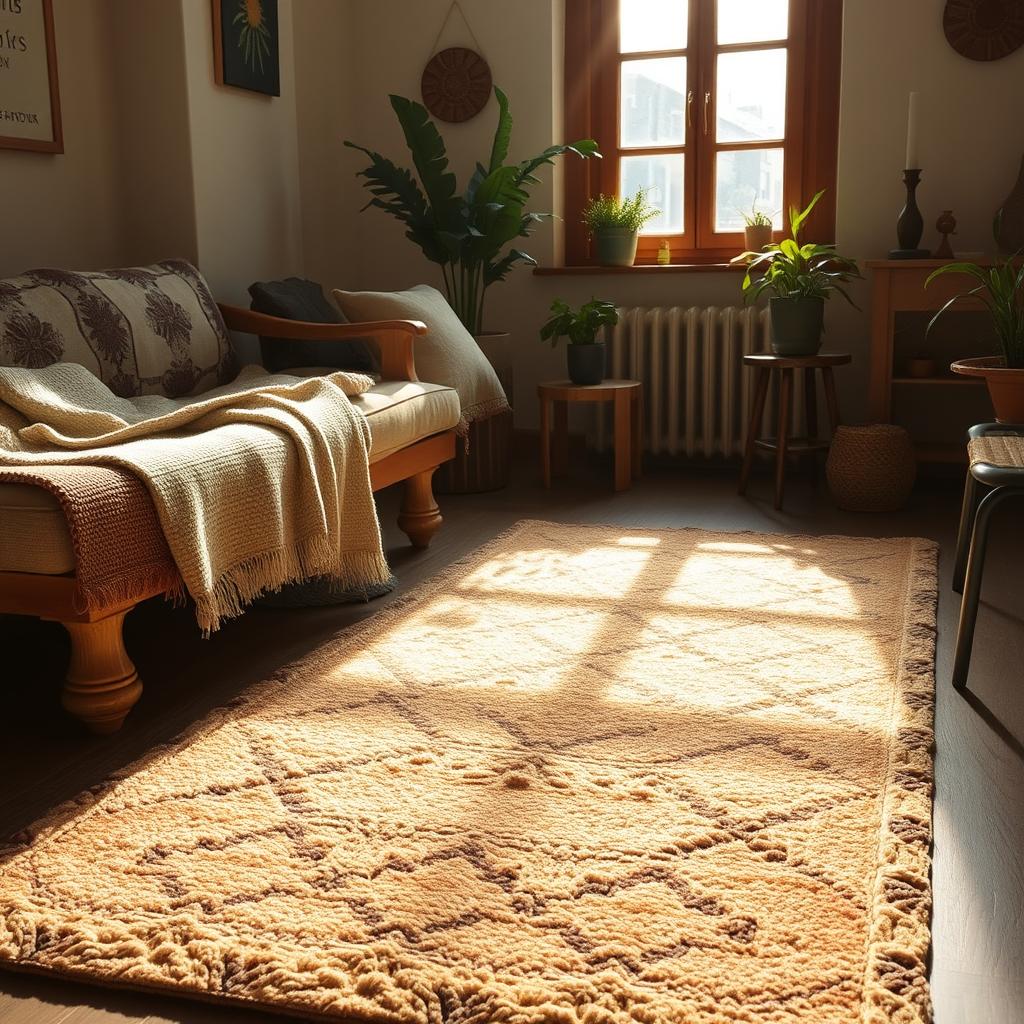
Storing and Protecting Your Heirloom Textiles
Keeping your heirloom textiles, like ethnic rug designs, in great shape is important. You need to think about where you store them and how you wrap them. Climate control and wrapping are key.
Climate Control Considerations
The place where you store your textiles matters a lot. It should be cool, between 65-75°F, and not too humid, 30-50%. Don’t let your textiles get too much sunlight or face sudden changes in temperature and humidity. This can cause fading, damage to fibers, and more.
Proper Rolling and Wrapping Methods
- Roll the textile around a clean, acid-free tube or cardboard core, with the front of the textile facing outward.
- Wrap the rolled textile in acid-free tissue paper or a clean, breathable cotton cloth to protect it from dust and light.
- Store the wrapped textile in a sturdy, archival-quality storage box or container, ensuring it is not compressed or folded.
- Label the container with the contents and any relevant information, such as the date of acquisition or the item’s history.
Using these storage and wrapping tips can keep your heirloom textiles, including ethnic rug designs, looking good for years. This way, you can pass on their beauty and cultural value to future generations.
Dealing with Spills and Stains
Accidents can happen, especially with handmade and wool carpets. But, with the right steps, you can keep your rugs looking great. Here are some tips for handling spills and stains on your floors.
Immediate Response is Key
Acting fast is crucial when dealing with spills and stains. The sooner you act, the less damage there will be. Here’s how to respond quickly:
- Use a clean cloth or paper towels to soak up as much liquid as you can.
- Don’t rub or scrub, as this can make the stain worse and push it deeper.
- If the spill is solid or semi-solid, carefully scrape it off with a dull knife or spoon.
Targeted Cleaning Techniques
After you’ve cleaned up the spill, it’s time to tackle the stain. The right method depends on the type of stain:
- Water-based Stains: Use a clean, damp cloth and then a mild soap solution.
- Oily Stains: Apply a degreasing agent, like a carpet-safe solvent or vinegar solution.
- Stubborn Stains: For tough stains, get help from a professional carpet cleaner.
Always test any cleaning solution on a small, hidden area first. This ensures it won’t harm your carpet. By acting fast and using the right cleaning methods, you can handle spills and stains on your handmade and wool carpets. This will protect your investment and keep your floors beautiful.
Repair and Restoration Considerations
Even the most beautiful hand-knotted carpets can wear out over time. But with the right help, they can be made new again. It’s key to know the common damages and find skilled restorers who know traditional weaving.
Common Damage Types
Hand-knotted carpets can face many issues like frayed edges and stains. Quick care and attention can lessen these problems. Common issues include:
- Worn or thinning areas due to high-traffic zones
- Snags, tears, and holes caused by furniture or foot traffic
- Color fading from excessive sun exposure
- Stains and soiling from spills or long-term neglect
Finding Qualified Restorers
Finding the right person to fix your carpet is crucial. Look for experts who love and understand traditional weaving. They should know how to fix your carpet without losing its special touch.
Good restorers offer many services like color fixing and reweaving. They can make your carpet look like new again. By choosing the right experts, you ensure your carpet is fixed with care and respect for its heritage.

Tips for Extending Carpet Lifespan
Choosing high-quality artisan rugs and sustainable home decor is a smart move. But, to keep them looking great for longer, you need to take good care of them. Follow a few easy tips to make your carpets last longer and stay beautiful in your home.
Preventive Measures
- Place doormats at all entrances to catch dirt and debris before it hits your carpets.
- Move your furniture around now and then to avoid wear patterns in busy spots.
- Use coasters or pads under heavy furniture to stop it from leaving marks or dents.
Diligent Maintenance
- Vacuum often, using the right attachments and settings for your carpet.
- Quickly clean spills with a clean cloth to stop stains from setting in.
- Turn your carpets every few months to keep them evenly worn and sun-kissed.
Lifestyle Adjustments
Changing a few habits can also help your artisan rugs and sustainable home decor last longer:
- Take off your shoes before walking on carpets to cut down on dirt and wear.
- Ask your guests to do the same, or offer them shoe covers.
- Avoid dragging heavy furniture across your carpets to prevent lasting dents.
| Maintenance Tip | Benefit |
|---|---|
| Rotate carpets regularly | Promotes even wear and sun exposure |
| Use furniture coasters | Prevents indentations and damage |
| Remove shoes before walking on carpets | Reduces dirt, debris, and abrasion |
By adding these simple tips to your daily routine, you can make your artisan rugs and sustainable home decor last longer. They will stay a beautiful and cherished part of your home for many years.
Conclusion
Throughout this guide, we’ve learned how important it is to take care of handmade and wool carpets. They are not just floor coverings but also valuable investments and pieces of art. By following the right care tips, you can keep them looking great for a long time. Following the care routines and addressing threats early on is key. Sometimes, you might need professional cleaning. By doing so, you protect your carpets as treasured family items. Seasonal care and proper storage can also help them last longer, so you can enjoy them for years.
Looking after your handmade and wool carpets shows how much you value them. With the knowledge from this guide, you can keep their craftsmanship and cultural value alive. This way, they will continue to add beauty and meaning to your home for many years.
FAQ: Maintenance & Care of handmade and wool carpets
What are the essential tools and supplies needed for maintaining handmade and wool carpets?
You’ll need a good vacuum, a soft-bristled brush, and a carpet sweeper. Also, spot cleaning solutions and a professional-grade carpet cleaner are key. Choose eco-friendly products to protect the delicate fibers.
How often should handmade and wool carpets be vacuumed?
Vacuum them once a week, or more in busy areas. Use the right vacuum attachment and avoid too much suction to keep the carpet in good shape.
What are the common threats to natural fiber flooring like handmade and wool carpets?
Direct sunlight, humidity, and temperature changes can harm them. Pests like moths and beetles can also damage the wool. Foot traffic and spills can wear them down over time.
When is it necessary to have a handmade or wool carpet professionally cleaned?
Get them professionally cleaned every 12 to 18 months. Or more often if they’re in busy areas or have gotten dirty. A pro can make them look new again and last longer.
How can I properly store and protect my handmade and wool carpets when not in use?
Keep them in a place with stable temperature and humidity. Roll or fold them carefully. Use acid-free tissue or muslin to protect them. Store them in a dark, dry spot to prevent damage.
What should I do if I spill something on my handmade or wool carpet?
Act fast if you spill something. Blot it with a clean cloth or paper towels. Don’t rub it. Use a mild carpet cleaner for natural fibers. If it’s hard to clean, get a pro’s help.
How can I extend the lifespan of my handmade or wool carpet?
Rotate the carpet to even out wear. Limit sunlight and use furniture pads. Get it professionally cleaned regularly. Proper care will keep it looking great for years.

